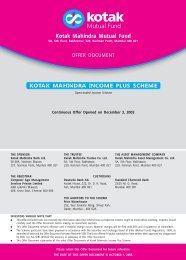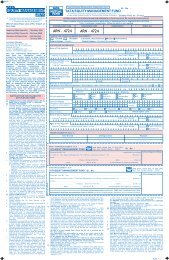OFFER DOCUMENT
Balanced Offer Document - Appuonline.com
Balanced Offer Document - Appuonline.com
- No tags were found...
You also want an ePaper? Increase the reach of your titles
YUMPU automatically turns print PDFs into web optimized ePapers that Google loves.
Prudential ICICI Balanced Fund<br />
Exposure to Derivatives:<br />
The respective schemes of Prudential ICICI Mutual Fund shall, under normal circumstances, not have exposure of more<br />
than 25% of its net assets in the derivative instruments. The AMC in times of market volatility and other abnormal<br />
market conditions increase such exposure in derivative instruments up to maximum of 50% of net assets under each<br />
scheme with a view to protecting the interests of the investors under the schemes.<br />
The following information provides a basic idea as to the nature of the derivative instruments proposed to be used by<br />
the Fund and the risks attached there with.<br />
Advantages of Derivatives:<br />
The volatility in Indian markets both in debt and equity has increased over last few months. Derivatives provide unique<br />
flexibility to the Scheme to hedge part of its portfolio. Some of the advantages of specific derivatives are as under :<br />
Index Futures :<br />
a) Investment in Stock Index Futures can give exposure to the index without directly buying the individual stocks.<br />
Appreciation in Index stocks can be effectively captured through investment in Stock Index Futures.<br />
b) Subject to Regulations, the Fund can sell futures to hedge against market movements effectively without actually<br />
selling the stocks it holds.<br />
Interest Rate Swaps and Forward rate Agreements:<br />
Bond markets in India are not very liquid. Investors run the risk of illiquidity in such markets. Investing for short-term<br />
periods for liquidity purposes has its own risks. Investors can benefit if the Fund remains in call market for the liquidity<br />
and at the same time take advantage of fixed rate by entering into a swap. It adds certainty to the returns without<br />
sacrificing liquidity.<br />
The following are illustrations how derivatives work. :<br />
Basic Structure of an Interest Rate Swap<br />
Floating Interest Rate<br />
Counter Party 1 Fixed Interest Rate<br />
Counter Party 2<br />
In the above illustration,<br />
Basic Details: Fixed to floating swap<br />
Notional Amount: Rs. 5 Crores<br />
Benchmark: NSE MIBOR<br />
Deal Tenor: 3 months (say 91 days)<br />
Documentation : International Securities Dealers Association(ISDA).<br />
Let us assume the fixed rate decided was 10%<br />
At the end of three months, the following exchange will take place:<br />
Counter party 1 pays: compounded call rate for three months, say 9.90%<br />
Counter party 2 pays fixed rate: 10%<br />
In practice, however, the difference of the two amounts is settled. Counter party 2 will pay Rs 5 Crores *0.10%* 91/365<br />
= Rs. 12,465.75<br />
Thus the trade off for the Fund will be the difference in call rate and the fixed rate payment and this can vary with the call<br />
rates in the market. Please note that the above example is given for illustration purposes only and the actual returns may<br />
vary depending on the terms of swap and market conditions.<br />
Basic Structure of a Stock Index Future<br />
The Stock Index futures are instruments designed to give exposure to the equity market indices. The Stock Exchange,<br />
Mumbai and The National Stock Exchange have started trading in index futures of 1, 2 and 3-month maturities. The<br />
pricing of an index future is the function of the underlying index and short-term interest rates.<br />
Example:<br />
Assumptions:<br />
1 month BSE 30 Future<br />
Spot Index: 4900<br />
Future Price on day 1: 4920<br />
Fund buys 10,000 futures<br />
Date of settlement<br />
31









